Abstract
The problems of human resource management in the regions with natural loss and migration outflow of the population in the Russian Federation are largely due to the demographic situation in the country. According to Rosstat forecasts, the year 2036 will also see a decrease in the population of Russia. At the same time, the projected migration increase due to external migration will not compensate for the negative value of the natural population growth. In recent years, there has been a change in the pattern of migration behaviour of the population of Russia. The management of labor migration is an important task of managing labor resources of the regions due to the lack of natural population growth in Russia at present and in the future. Managing labor resources implies the development of mechanisms and tools for effective regulation of regional labor migration. Disproportionality of the levels of socio-economic development of regions is observed in many countries. However, in Russia, the differentiation is significant even within a single federal district and is huge across the country. Obviously, even today, the joint actions taken by the federal executive authorities, the state authorities of the constituent entities of the Russian Federation and the local governments have so far failed to balance the socio-economic development of the regions. It is necessary to overcome regional differences in incomes of the population and the level of differences in social infrastructure to optimize the direction of internal migration of the population.
Keywords: Labor resourcesmigrationregional labor migration
Introduction
Demographic situation in the Russian Federation
Problems of human resource management in regions with natural decline and migration outflow of the population in the Russian Federation are largely due to the demographic situation in the country.
At the end of the twentieth century, the country entered a period of population decline (Figure
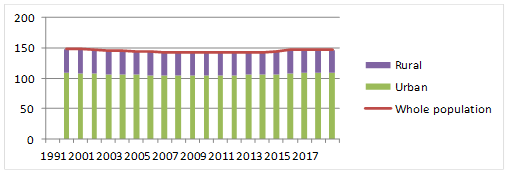
Figure
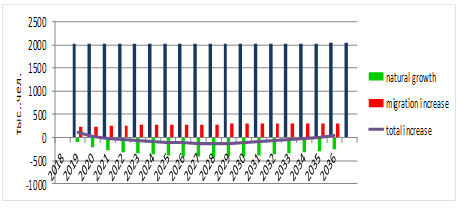
The dynamics of indicators in Figure
The main results of migration in Russia
It is worth considering the fact that labor migration has a great impact on regional labor markets not only in Russia, but also in Europe. As Adrian Otoiu points out in his article (Adrian, 2014), in most cases labor migration is due to potential economic opportunities in a new place, namely, obtaining a higher income, the likelihood of finding a job, changing marital status, etc. Similarly for Russia, the cause of labor migration of the population is, first of all, the search for a higher potential income. So, considering the results of migration in the Russian Federation for 2005-2017 (Figure
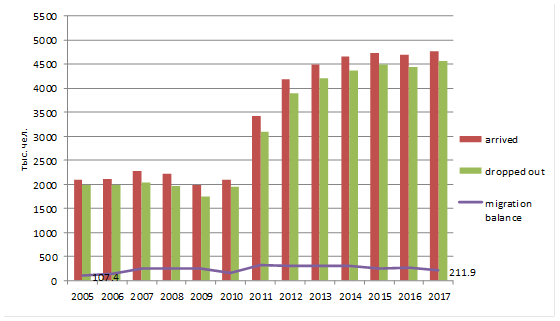
The dynamics of population migration, noted in Figure
Directions of population migration
Considering the direction of migration, it is worth noting that it occurs within the Russian Federation - between urban and rural settlements, between urban settlements and between rural settlements within one district / subject of the Russian Federation / federal district and between them. The combination of these areas of population transfer is the form of internal migration. From the point of view of M.P. Todaro (Todaro & Maruszko, 1987), internal migration is more preferable in comparison with external, since the sources of internal migration are more often young people who are better educated and oriented to success than the general population in the field of emigration. In addition to internal migration, it is also necessary to consider the characteristics of external migration, which represents the movement of population between the Russian Federation and other countries (Figure
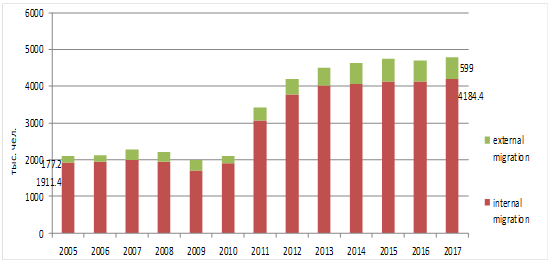
As the data of Figure
On the basis of the data presented in Figure
A confirmation of the change in the model of migration behavior of the population, including the increase in the intensity of internal migration, is the fact that individuals living in the previous place from birth are increasingly involved in intra-regional resettlements, so their share increased from 16.3% in 2008 to 20.6% in 2016.
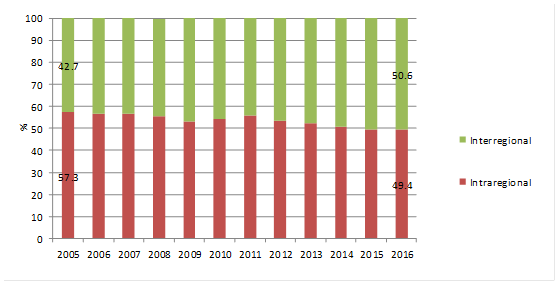
At the same time, the frequency of repeated migrations within the framework of intraregional movements increases. So, if in 2008 migrants re-participating in intraregional territorial movements lived in the previous place of residence on average for 12.2 years, then in 2016 it already made only 6.4 years (Figure
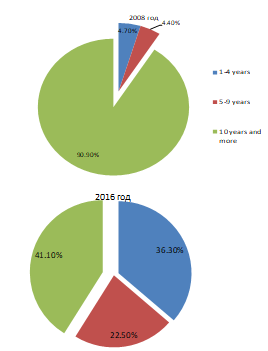
The growing territorial mobility of the population shown in Figure
The change in the model of migration behavior of the population can be viewed as a whole as a positive phenomenon in a market economy and it is very important from the standpoint of solving a number of current and future social and economic problems in Russia. Among them are the following: the prevention of stagnant unemployment and the achievement of a balance in regional labor markets, the promotion of economic development of promising areas, the optimization of the population structure in the interests of demographic development, etc.
For this reason, taking into account changes in the model of migration behavior of the population of Russia, it is advisable to adjust the goals, objectives and targets (indicators) with regard to internal migration of the population in the strategic planning documents of the Russian Federation, including those in state programs of the Russian Federation. In particular, it is necessary to establish target figures for organizing resettlement/territorial mobility, including unemployed citizens taking into account the quantitative characteristics of internal migration. It is also advisable to fix the effect of internal migration on the change in population in the regions of Russia in the strategic planning documents of the Russian Federation.
A significant role in the migration of the population in Russia is also performed by external (interstate) migration, ensuring, among other things, the migration increase in the country's population. So, there was a fairly steady growth in the number of persons arriving from foreign countries in 2007-2017, except for the period of economic crisis, when the number of arrivals decreased. The increase in arrivals was mainly due to residents of the CIS countries, and to a much lesser extent due to migrants from other countries.
At the same time, there was a departure of the population from Russia abroad in 2007–2017, both to the CIS countries and to other states. However, the dynamics of departures within the framework of external migration was somewhat different. The relative stability of departures in 2007-2011 (fluctuations in the range from 37 to 47 thousand people) was replaced by a spasmodic growth that began in 2012 at around 122.7 thousand people and lasted until 2017, when the departures reached 377.1 thousand people. It can be concluded that the reduction in the migration increase (balance) of external (interstate) migration in Russia during the crisis period resumed in the post-crisis years and it was quite stable up to 2017 based on the data presented.
Problem Statement
Causes of population migration
Analysis and identification of the causes of regional migration (Table
As the data in Table
As the data of Table
Regulation of labor migration in regions with natural loss and migration outflow of the population
In recent years, the regulation of regional labor migration in Russia has been carried out through legal, financial, economic, organizational and other instruments. The most effective instrument for regulating regional labor migration are instruments for regulating migration within the framework of measures determined by the State Program to assist the voluntary resettlement of compatriots living abroad to the Russian Federation (Table
Thus, the growth in the number of participants in the State Program for the Resettlement of Compatriots, especially in 2014–2016, which is shown in Table
It can be concluded that the increase in the effectiveness of state regulation of migration will be facilitated by the following, taking into account the results of the analysis, as well as materials of publications in the media:
updating of the provisions characterizing the goals, objectives, priorities of the migration policy of Russia in the strategic planning documents of the Russian Federation and the subjects of the Russian Federation;
improvement of the interdepartmental coordination of federal executive bodies responsible for formulating and implementing public policy and legal regulation in the field of migration of the population with the aim to strengthen the validity of a number of provisions of strategic planning documents, use more effective regulatory measures, improve budget financing mechanisms, etc.;
differentiation of the system of benefits and compensation to migrants, as well as financial assistance to employers, depending on the categories of workers involved and the regions of moving in;
use of approaches used in the framework of public-private partnerships, while compensating for the costs for relocating of workers.
Research Questions
The main results and directions of migration.
Demographic and social characteristics of population migration.
Causes of population migration.
Migration factors.
Regulation of population migration.
Purpose of the Study
The aim of the study is to develop methods and tools for managing human resources in regions with natural loss and migration outflow of the population.
The objectives of the study are:
conducting an assessment of demographic situation and analysis of the labor market in regions with a natural decline in the population;
analysis of labor migration in regions with migration outflow of the population;
identifying the main factors affecting regional labor migration;
development of methods, tools, mechanisms for the management of labor resources in regions with natural loss and migration outflow of the population;
justification of recommendations to the state and municipal authorities to improve the efficiency of use of labor resources in regions with a natural decline and migration outflow of the population.
Research Methods
The following methods were used to solve the tasks set in the scientific article: economic and statistical, comparative analytical, sociological, expert assessments, correlation and regression analysis, source study, system analysis, economic and mathematical modelling, graphic modelling (Fischer & Pfaffermayr, 2017; Hung-Ju & I-Hsiang, 2013; King & Skeldon, 2010; Sanderson, 2013; Vincenzo & Leandro, 2016).
Findings
In 2005–2017 (with the exception of the crisis years of 2008–2009), a general growth trend was observed for the main indicators of population migration in the Russian Federation: the number of arrivals and departures the balance of migration growth for this period showed positive values.
The parameters of the macroeconomic situation in Russia in 2005–2016, including the dynamics of the ruble exchange rate, had a significant influence on the main migration indicators. In turn, external (interstate) migration contributed to a definite solution of the demographic problems of the Russian Federation due to the influx of able-bodied population, as well as to the relocation of people with vocational education to the country.
The decrease in migration growth (balance) of foreign (interstate) migration in Russia observed after 2011 indicates a decrease in the migration attractiveness of our country for foreign citizens, due, among other things, to the falling purchasing power of the average monthly nominal wages of workers in the Russian economy in dollar equivalent, caused by the weakening of the ruble against the dollar.
Increasing of migration growth is advisable not so much by increasing the influx of population from abroad, but by reducing the volume and intensity of migrants leaving, increasing their survival rate in the new place of residence, which can be considered as one of the promising tasks of the migration policy of the country.
The intensity of internal migration in the constituent entities of the Russian Federation is influenced by such indicators of regional socio-economic development as:
the level of economic development of the regions;
parameters of the living standard of the population;
levels of development and availability of social infrastructure in the regions;
crime level.
Optimization of the directions of internal migration of the population is possible by overcoming regional differences in income levels and poverty of the population, leveling of the development of social infrastructure, accessibility of facilities and the social services provided by them considering the above mentioned.
The existing benefits used to support the territorial movements of the unemployed for employment / relocation to another locality do not have the desired effect due to small scale, they do not encourage and will not stimulate the territorial population movements with the aim of reducing unemployment and regulating migration. It is advisable in this regard to use the proven positive experience in encouraging voluntary resettlement accumulated in international practice.
Conclusion
Thus, the main directions of regulation of labor resources in the regions with natural decline and migration outflow of the population should be the following:
development of classification approaches to the study of labor migration by factors, types and other aspects and directions;
development of a system for assessing the significance of factors affecting labor migration in the region;
development of a methodology for determining the need for labor resources in regions with a natural decline and migration outflow of the population, including the need for migrant workers;
determination of conditions of attraction, selection procedure, restrictions, length of stay of labor migrants in the host country;
development of a point system in the selection of migrant workers based on certain criteria and indicators;
development of indicators of economic efficiency of attracting labor migrants to the regional labor market and the legalization of their labor;
development of differentiated programs for attracting labor migrants;
development of a methodology for assessing the satisfaction of migrant workers with the process of socio-economic adaptation in the regional labor market.
The data obtained allow us to conclude that the solution to the problem of increasing migration growth as a means of compensating for the natural population decline should be based not only and not so much on increasing the number of migrants receiving, but on reducing their departure, on increasing their survival rate in the new place of residence.
References
- Adrian, O. (2014). Getting your Migration Analysis Together by Integrating Internal and International Migration. Social and Behavioral Sciences, 149, 685–690. https://dx.doi.org/10.1016/j.sbspro.2014.08.254
- Fischer, L. B., & Pfaffermayr, M. (2017). The more the merrier? Migration and convergence among European regions. Regional Science and Urban Economics, 72, 103-114. Advance online publication.
- Hung-Ju, C., & I-Hsiang, F., (2013). Migration, social security, and economic growth. Economic Modelling, 32, 386-399.
- King, R., & Skeldon, R. (2010). ‘Mind the Gap!’ Integrating Approaches to Internal and International Migration. Journal of Ethnic and Migration Studies, 36(10), 1619-1646. https://dx.doi.org/10.1080/1369183X.2010.489380.
- Official site. Federal State Statistics Service. Demography. Received April 30, 2018, from http://www.gks.ru/wps/wcm/connect/rosstat_main/rosstat/ru/statistics/population/demography
- Sanderson, M. R. (2013). Does immigration have a Matthew Effect? A cross-national analysis of international migration and international income inequality, 1960-2005. Social Science Research, 42, 683-697.
- Todaro, M.P., & Maruszko L. (1987). Illegal Migration and US Immigration Reform: A Conceptual Framework. Population and development review, 13 (1), 101-114.
- Vincenzo, B., & Leandro, E. (2016). Migration, Diversity, and Economic Growth. World Development, 89, 227-239. https://dx.doi.org/10.1016/j.worlddev.2016.08.012
Copyright information

This work is licensed under a Creative Commons Attribution-NonCommercial-NoDerivatives 4.0 International License.
About this article
Publication Date
02 April 2019
Article Doi
eBook ISBN
978-1-80296-058-7
Publisher
Future Academy
Volume
59
Print ISBN (optional)
-
Edition Number
1st Edition
Pages
1-1083
Subjects
Business, innovation, science, technology, society, organizational theory,organizational behaviour
Cite this article as:
Plakhova, L., Bardovskii, V., Zviagintceva, Y., Alekhina, L., & Troshina, E. (2019). Labor Resources Management In Regions With Natural Population Decline And Migration Outflow. In V. A. Trifonov (Ed.), Contemporary Issues of Economic Development of Russia: Challenges and Opportunities, vol 59. European Proceedings of Social and Behavioural Sciences (pp. 500-510). Future Academy. https://doi.org/10.15405/epsbs.2019.04.54

